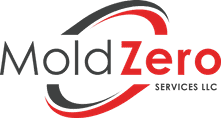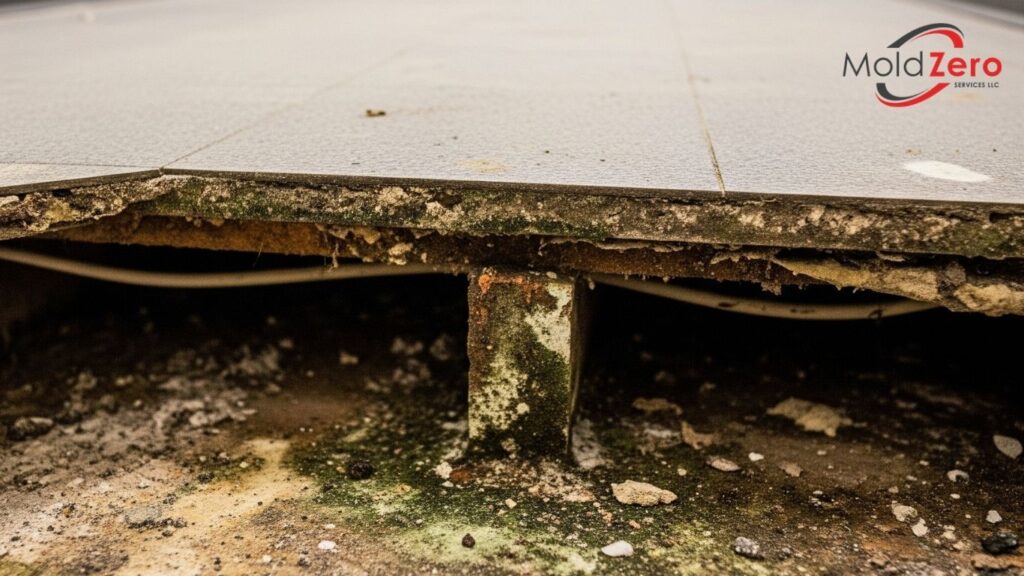Common Hidden Mold Sources in Commercial Buildings
For Los Angeles business owners and commercial property managers, maintaining a healthy and inviting commercial space is essential. However, a significant threat can lurk unseen: hidden mold.
Unlike visible patches that are quickly addressed, hidden mold can proliferate undetected, leading to property damage and impacting indoor environment quality before it’s even discovered.
Identifying these elusive growth areas is critical to protecting your investment and the well-being of your occupants. Mold Zero specializes in uncovering and providing solutions for hidden mold that commercial properties in the Los Angeles area often face.
The challenge with hidden mold is its insidious nature. It thrives in darkness and moisture, often stemming from slow leaks, condensation, or inadequate ventilation tucked away from plain sight. In a city like Los Angeles, with its mix of modern and older commercial constructions, the potential for these hidden mold issues is substantial.
Ignoring this possibility can lead to more extensive and costly remediation needs. Early detection through professional mold inspection is key.
The Distinct Risks Posed by Hidden Mold to Your Los Angeles Enterprise
Hidden mold presents unique challenges for commercial properties, primarily because its concealed growth allows more time for damage to occur and spread.
Impact on Property Integrity
Undetected mold gradually deteriorates building materials like drywall, wood framing, and insulation. Over time, this can compromise structural elements, especially if moisture issues persist. Addressing this effectively requires comprehensive mold remediation expertise.
Concerns for Indoor Environment Quality
Mature hidden mold colonies release spores into the air. HVAC systems can circulate these particulates throughout the building, potentially degrading the indoor environment quality over a wide area. Occupants might notice persistent musty odors or experience discomfort, a particular concern for those with sensitivities.
Escalation of Problems and Costs
Allowing hidden mold to linger often leads to more significant disruptions and substantially higher repair and remediation costs when the problem eventually becomes too large to ignore. Early intervention is invariably more cost-effective.
Unmasking Common Hidden Mold Havens in Los Angeles Commercial Buildings
Understanding where mold prefers to hide is the first step in a proactive approach. Our extensive experience conducting mold inspections in Los Angeles commercial buildings has shown that certain areas are consistently more vulnerable. Awareness of these hotspots, as highlighted by resources from organizations like InterNACHI (International Association of Certified Home Inspectors) regarding professional mold assessment, can help you stay vigilant.
Within Wall Cavities and Beneath Wallpaper
- Why Walls Are Vulnerable: The spaces within wall cavities and behind wallpaper are prime locations. Moisture from slow pipe leaks, condensation (especially on exterior walls), or minor construction defects creates the damp, dark conditions mold loves.
- Spotting Elusive Signs: A persistent musty smell is often the first clue. Look for subtle discoloration on walls, peeling wallpaper, or warped materials. Sometimes, an odor is the only early warning.
- Mold Zero’s Approach: Our Los Angeles commercial mold inspections may use moisture meters and other non-invasive tools to detect moisture within walls. If mold is confirmed, our minimally invasive remediation techniques address the issue effectively.
Above Suspended Ceilings and in Attic Voids
- Why Overhead Spaces Are Prone: Ceiling voids and attics can hide significant mold growth. Roof leaks, condensation on pipes or HVAC components, or high humidity in poorly ventilated attics are common culprits.
- Detecting Overhead Growth: Sagging or stained ceiling tiles are obvious, but sometimes only a musty odor (especially when the HVAC runs) or unusual debris from ceiling crevices provides a hint.
- Our Strategy: We carefully inspect these areas. Our remediation, including HEPA vacuuming and targeted fogging, effectively addresses mold on surfaces without extensive dismantling.
Lurking Beneath Flooring, Subfloors, and Carpeting
- Why Underfoot Areas Are Susceptible: Spaces beneath flooring can harbor mold from spills seeping through padding, moisture from concrete slabs, or undetected plumbing leaks. Improper cleaning leaving carpets damp also contributes.
- Identifying Underfloor Signs: Persistent musty odors, darkened grout lines, discolored or damp-feeling carpeting, or warped/loose hard flooring can indicate underlying mold.
- Addressing Underfloor Mold: Detection requires careful assessment. Our team determines the best action, from specialized cleaning and treatment to recommending material replacement if deterioration is advanced.
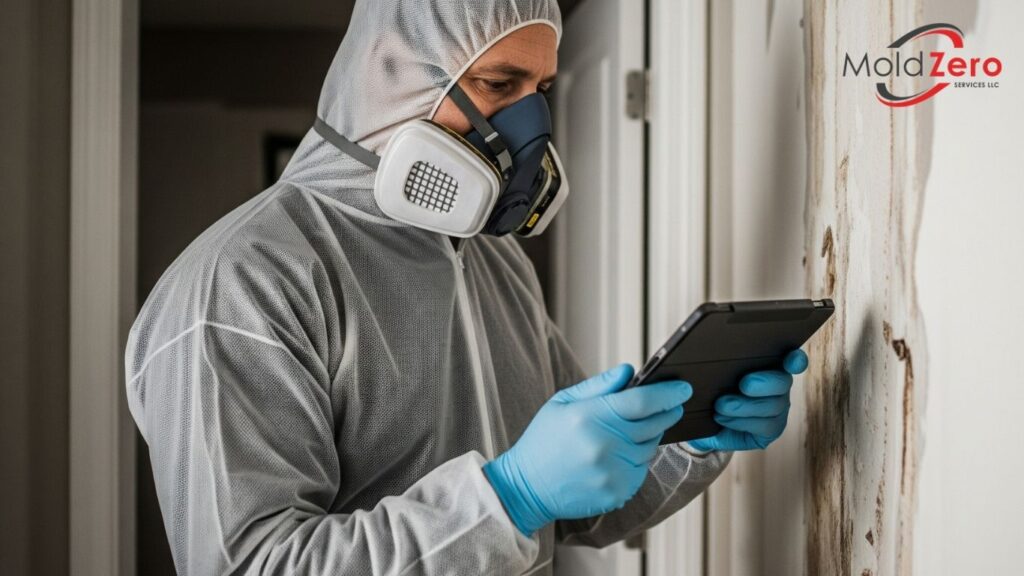
Inside HVAC Systems and Ductwork Labyrinths
- Why HVAC Systems Can Harbor Mold: HVAC systems, if not properly maintained, can become breeding grounds and distribution networks for mold. Condensation in air handlers, on coils, or in drain pans can lead to growth, which ductwork then spreads.
- Recognizing HVAC Mold Issues: A persistent musty odor when the system runs is a primary indicator. Occupants might also note damp air or increased dust. Visible mold on vents is a late-stage sign.
- Managing HVAC-Associated Mold: While we remediate surfaces, we advise that HVAC systems be regularly serviced by qualified HVAC professionals. Our process addresses mold on vents and surrounding areas.
The Usual Suspects: Basements, Cellars, and Crawl Spaces
- Why Lower Levels Are High-Risk: These areas are prone to moisture from high humidity, foundation leaks, sump pump failures, or poor ventilation, especially in older Los Angeles structures.
- Uncovering Lower-Level Mold: Earthy or musty smells are common. Look for efflorescence on foundation walls, dampness on stored items, or condensation on pipes.
- Mold Zero’s Solution: These areas often need a thorough approach. Our 5-step remediation process addresses existing growth and makes surfaces inhospitable to future mold.
Concealed Near Plumbing Fixtures and Within Cabinetry
- Why Plumbing Areas Foster Mold: Areas around sinks, toilets, and other water-using appliances, especially inside cabinets or wall cavities with plumbing, are frequent hotspots due to slow, unnoticed leaks or condensation.
- Clues to Plumbing-Related Mold: Warped cabinet bases, wall discoloration near fixtures, musty odors in cabinets, or loose tiles can point to a hidden issue.
- Our Method: We conduct detailed inspections. Our targeted treatments address mold, and we always emphasize repairing the leak source to prevent recurrence.
Overlooked Storage Areas, Utility Closets, and Janitorial Rooms
- Why Utilitarian Spaces Are Vulnerable: These less-frequented areas often have poor ventilation and can house inadvertently damp items. Infrequent checks mean leaks or condensation can go unnoticed, allowing mold to establish.
- Finding Mold in Utilitarian Spaces: A musty odor, visible growth on stored items (especially cardboard or textiles), or signs of water damage are common.
- Ensuring Thoroughness: Mold Zero meticulously inspects and treats these often-neglected spaces, as they can be significant hidden reservoirs of mold spores.
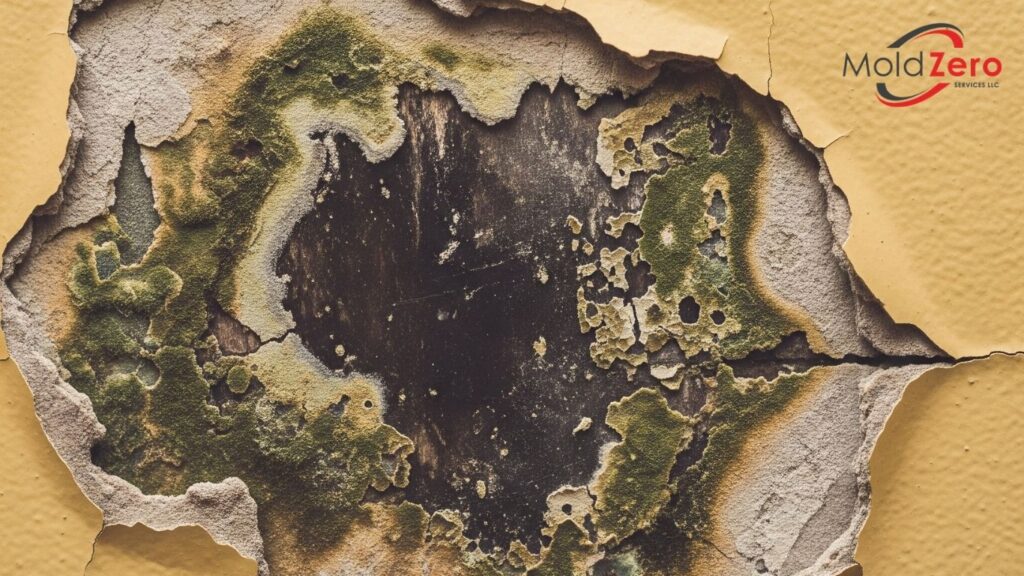
Proactive Strategies for Hidden Mold Prevention in Your LA Commercial Building
While Mold Zero is ready to address existing mold, prevention is always preferred. Implementing these proactive measures can significantly reduce the risk of hidden mold in your Los Angeles commercial property:
Prioritize Vigilant Moisture Control
This is foundational for mold prevention. Regularly inspect for and promptly repair any water leaks from plumbing, roofs, or HVAC systems. Ensure proper exterior drainage.
Actively Manage Indoor Humidity Levels
Maintain indoor humidity ideally between 30-50%. Use commercial-grade dehumidifiers in moisture-prone areas if needed, and ensure robust ventilation.
Implement Regular Maintenance and Thorough Inspections
Establish a routine maintenance schedule checking common problem areas like HVAC drain pans, basements, and around plumbing. Look for water damage or musty odors.
Promote Sufficient Air Circulation
Ensure adequate air circulation throughout the building. Avoid blocking vents and consider using fans in stagnant areas.
Encourage Staff Awareness and Reporting
Train staff and encourage tenants to immediately report any signs of water leaks, moisture, or musty odors. Swift reporting allows for quicker resolution.
Schedule Periodic Professional Mold Assessments
Consider an annual professional mold inspection, especially for older buildings or those with a history of moisture issues. Our experts can spot early warning signs.
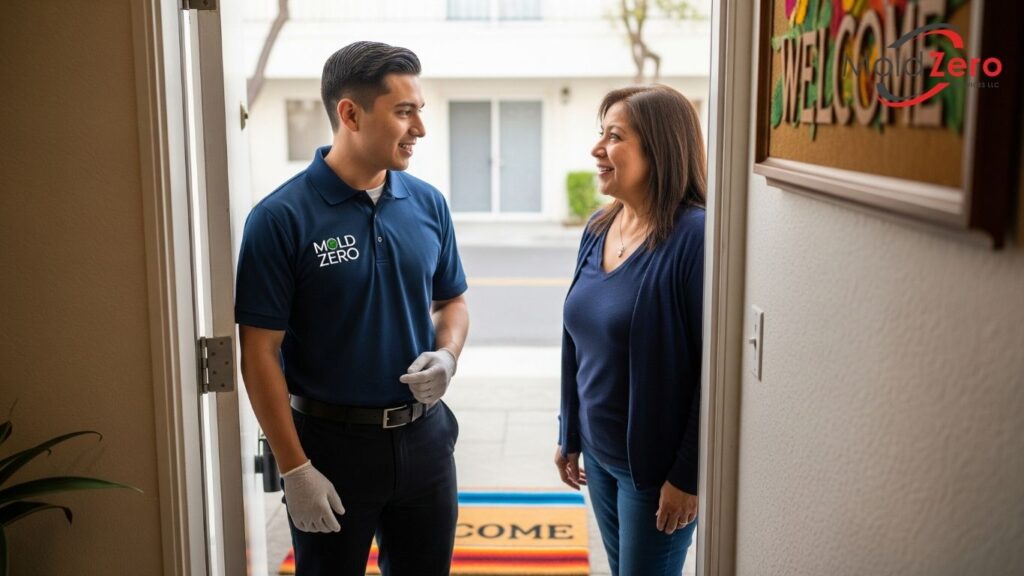
Why Entrust Mold Zero with Uncovering and Addressing Hidden Mold in Los Angeles?
When you suspect hidden mold, partnering with a trusted specialist is crucial. Mold Zero offers a distinct, thorough approach for these challenging situations.
Our Specialized Expertise in Commercial Mold Detection
Our NORMI certified team has successfully completed over 1000 mold remediation jobs. This experience provides a deep understanding of commercial structures and where mold commonly hides.
Our Advanced Minimally Invasive Remediation Process
Our commitment to your property’s well-being guides our 5-step mold remediation method, detailed on our Commercial Mold Removal services page. It’s engineered to be highly effective and significantly minimally invasive, often allowing us to address hidden mold with less disruption than traditional methods. Our process includes HEPA vacuuming, hygienic damp wiping, and a two-step fogging process using solutions we would trust in our own family environments.
Goldshield Technology for Lasting Protection
The second fogging step applies Goldshield, creating an invisible barrier on treated surfaces that makes them inhospitable to new mold growth, offering lasting protection.
Our Guarantee and Commitment to Verified Results
We provide a 1-year guarantee against new mold growth on treated surfaces (provided no new water intrusions). Our process also includes post-treatment mold testing by an independent, third-party laboratory, offering objective confirmation of success and peace of mind. This commitment defines our service.
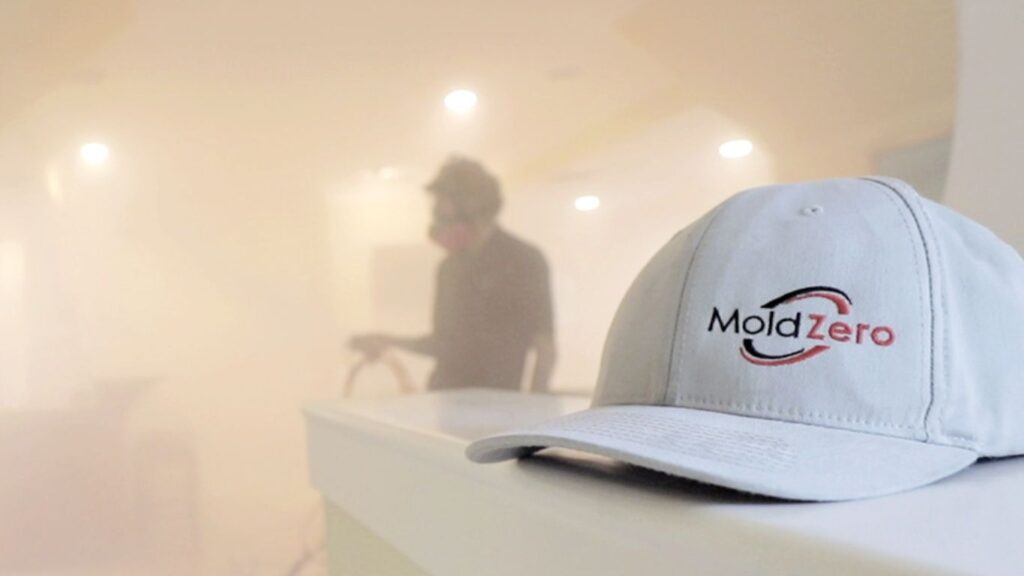
Don’t Let Hidden Mold Compromise Your Los Angeles Commercial Property
Hidden mold is a silent threat. The potential for property damage and impacts on the indoor environment are concerns that responsible Los Angeles property owners and managers cannot overlook. Proactive inspection and swift remediation are key.
If you’ve noticed subtle signs, persistent musty odors, or have concerns about potential hidden mold, don’t wait for the problem to escalate. Protect your investment and ensure a better indoor environment.
Contact Mold Zero Services LLC today at (626) 671-8885 or fill out our online form for a free, no-obligation inspection and quote. Let our trained experts help you uncover and address any hidden mold issues in your Los Angeles commercial property.
